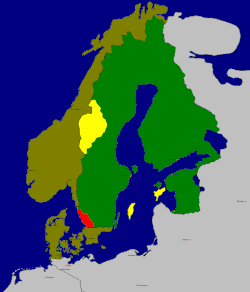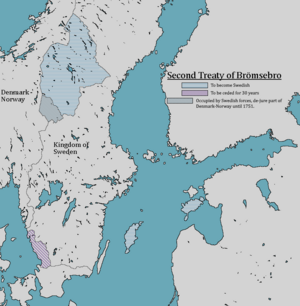|
Second Treaty of Brömsebro (1645)
 The Second Treaty of Brömsebro (or the Peace of Brömsebro) was signed on 13 August 1645, and ended the Torstenson War, a local conflict that began in 1643 (and was part of the larger Thirty Years' War) between Sweden and Denmark–Norway. Negotiations for the treaty began in February the same year. LocationThe eastern border between the then Danish province of Blekinge and the Swedish province of Småland was formed by the creek Brömsebäck. In this creek lies an islet that was connected to the Danish and Swedish riversides by bridges. On the islet was a stone that was supposed to mark the exact border between the two countries. By this stone, the delegates met to exchange greetings and, at the end of the negotiations, the signed documents.[1] The Danish delegation stayed in Kristianopel while the Swedish side had their accommodation in Söderåkra.[2] DelegationsSweden's highest ranking representative was Lord High Chancellor Axel Oxenstierna. He was accompanied by, among others, Johan Skytte, who died during the negotiations and was replaced by Ture Sparre.[2] Corfitz Ulfeldt and Chancellor Christen Thomesen Sehested were the chief negotiators of the Danish delegation.[2] The French diplomat Gaspard Coignet de la Thuillerie was head mediator and observers from the Hanseatic League, Portugal, Stralsund and Mecklenburg followed the negotiations.[2] ResultsThe military strength of Sweden ultimately forced Denmark–Norway to give in to Swedish demands.
The treaty was to be followed by the Treaty of Roskilde of 1658, which forced Denmark–Norway to further concessions. See also
Notes
References
|
||||||||||||
